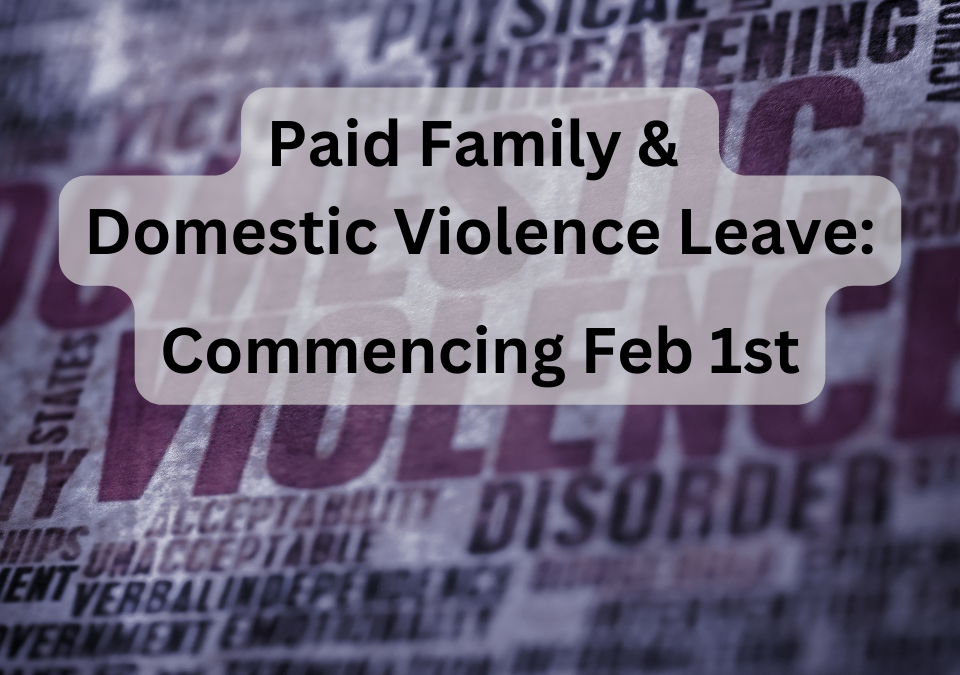As part of the recent changes to employment relations legislation, new paid family and domestic violence leave has now been introduced for employees. This change is effective from 1st February 2023.
It is important to note that the paid component of this leave is currently only applicable to businesses with more than 15 people. This paid leave will be applicable to small businesses (i.e. those with less than 15 people) from 1st August 2023.
The key highlights of this legislation are as follows:
- Full-time, part-time and casual employees will be able to access 10 days of paid family and domestic violence leave in a 12-month period. It won’t be pro-rated for part-time or casual employees. In other words, the entitlement is 10 days regardless of the number of hours per week an employee works.
- This new entitlement will replace the existing entitlement to 5 days of unpaid family and domestic violence leave
- Employees who start on or after 1st February 2023 can access the full 10 days from their first day of work. The leave will renew on their work anniversary.
- Employees who are already employed are able to access the full 10 days from 1st February 2023. The leave then renews on their work anniversary date (not 1st February each year).
- The full 10-day leave entitlement will be available upfront, however it won’t accumulate from year to year if it’s not used.
- From 1 February 2023, there are rules about information that must not be included on an employee’s pay slip relating to paid family and domestic violence leave – more on this below.
Who does the leave apply to? What is a “close relative”?
Under the new provisions, family and domestic violence means violent, threatening or other abusive behaviour by an employee’s close relative, a current or former intimate partner, or a member of their household that both:
- seeks to coerce or control the employee and
- causes them harm or fear.
A close relative is:
- an employee’s
- spouse or former spouse
- de facto partner or former de facto partner
- child
- parent
- grandparent
- grandchild
- sibling
- a child, parent, grandparent, grandchild or sibling of an employee’s current or former spouse or de fact partner, or
- a person related to the employee according to Aboriginal or Torres Strait Islander kinship rules.
When does this leave apply?
Employees (including part-time and casual employees) can take this paid leave if they need to do something to deal with the impact of family and domestic violence.
This could include, for example:
- making arrangements for their safety, or the safety of a close relative (including relocation)
- attending court hearings
- accessing police services
- attending counselling, and/or
- attending appointments with medical, financial or legal professionals.
How is the leave paid?
Full-time and part-time employees can take paid family and domestic violence leave at their full pay rate for the hours they would have worked if they weren’t on leave.
Casual employees will be paid at their full pay rate for the hours they were rostered to work in the period they took leave.
Note that an employee’s full pay rate includes their base rate plus any incentive-based payments and bonuses, loadings, monetary allowances, overtime or penalty rates any other separately identifiable amounts for the hours they would have worked, but the taking of the leave.
Employers need to keep a record of leave balances and any leave taken by employees. However, pay slips must not mention family and domestic violence leave, including any relevant leave taken and associated leave balances.
Evidence requirements
If an employee takes paid family and domestic violence leave, they are required to let their employer know as soon as possible. This could be after the leave has started. An employer can ask their employee for evidence to show that the employee needs to do something to deal with family and domestic violence and it’s not practical to do that outside their hours of work.
The evidence has to convince a reasonable person that the employee took the leave to deal with the impact of family and domestic violence, and the employer can only use this information for this purpose unless:
- the employee consents
- the employer is required to deal with the information by law, or
- it’s necessary to protect the life, health or safety of the employee or another person.
What should employers with more than 15 employees do now?
- Ensure your current policies reflect this paid leave – if no policy exists, consider developing one (reach out if you need assistance)
- Ensure you have a clear process in place to manage requests for this leave, noting in particular the sensitivities surrounding it. Ideally, you would have one central point of contact within the management / ownership team to be responsible for managing these requests. This will help ensure employee confidentiality is maintained as far as possible.
- If you have references to other types of leave within your employment contracts (beyond annual and personal / carer’s leave), ensure contracts for new employees also reflect this leave type.
- Ensure that your payroll software / payroll provider is updated to handle the requirement NOT to show this leave type on pay slips.
What should employers with less than 15 employees do?
- Get ready for the changes coming on 1st August – consider how you might also implement the above suggestions.
- Be aware that employees will continue to be entitled to 5 days of unpaid family and domestic violence leave until they can access the new paid entitlement.
Please call us if you require further information or would like to discuss a specific situation you are dealing with. You can also find more information on the Fair Work site here.
Note that this is general information only, not formal or legal advice. Information is current and we believe accurate at the time of publication – 23/01/2023.

